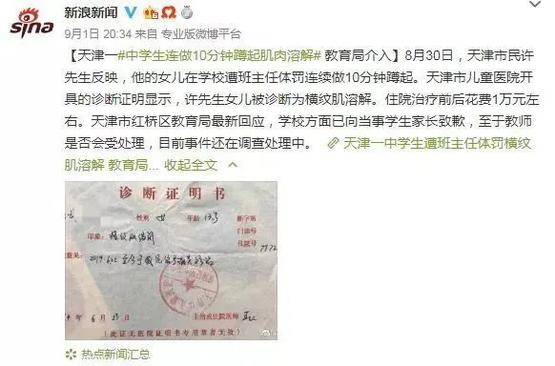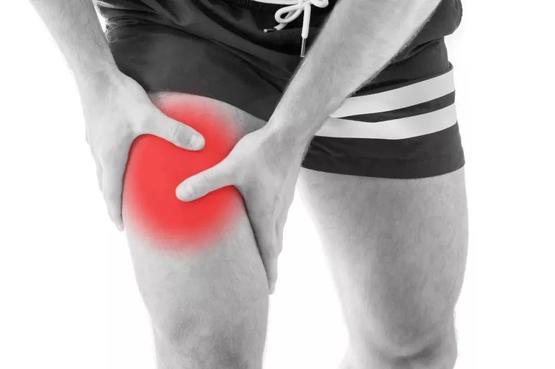In 2019, a piece of news appeared on Weibo’s hot search. A middle school student in Tianjin was physically punished by the head teacher and did squats for 10 minutes in a row. After returning home, the student felt pain in his legs, and the mother found that the child’s urine was black. After going to the hospital for examination, the child was diagnosed with “rhabdomyolysis”.
In fact, similar examples are not uncommon. For example, in a news story in July 2019, two girls competed in squatting, but they did not give way to each other. After each did 1,000 times, they were tied. But then, both developed kidney failure due to “rhabdomyolysis” and were admitted to the intensive care unit.

Figure丨Screenshot of Weibo
In recent years, reports of rhabdomyolysis have emerged, often during military training or in the gym. Isn’t it said that exercise is good for health, why is it still life-threatening? What is this disease?
Why do well-rounded muscles dissolve?
Human muscles are divided into striated muscle and smooth muscle. The striated muscle is mainly distributed in the bones and the heart, and is mostly in the bones. The striated muscles on the bones, also known as skeletal muscles, are responsible for our daily movements.
Rhabdomyolysis, also known as myosinuria, is a medical emergency. The so-called “dissolution” is just a popular saying. It does not mean that the muscles are really dissolved, but the cells that make up the muscles are ruptured, and the proteins and other substances in the cells enter the blood, causing a series of clinical symptoms.
Scientists have discovered many possible causes of rhabdomyolysis. One of the most common causes is the strenuous exercise mentioned at the beginning , such as heavy squats, long distance marches, and marathon running. Just like a rubber band can snap if stretched too far, anything can be damaged with overuse, so can strong skeletal muscles. Skeletal muscles that are located in anatomically confined spaces, such as the tibialis in the lower leg, are most vulnerable to excessive muscle movement.

Strenuous exercise is one of the common causes of rhabdomyolysis
In addition, adverse drug reactions, extreme body temperature, infections, metabolic disorders, high-voltage electrical shocks, burns, crush injuries, autoimmune diseases, etc. may also cause rhabdomyolysis.
Rhabdomyolysis easily affects the kidneys
Don’t underestimate the substances in striated muscle cells, they can play a positive role in the cells, but once they leak into the blood, they will not only not “work”, but also “disrupt”, which may lead to a series of serious illness.
Due to the rupture of muscle cells, patients with rhabdomyolysis generally experience muscle redness, swelling, pain, stiffness, etc. This pain is different from the muscle soreness after normal exercise, and is often accompanied by sudden fever and fatigue throughout the body.
In addition, such patients often have a typical symptom, that is, the urine becomes soy sauce-colored, tea-colored or red wine-colored , which is due to the excretion of myoglobin in the muscle cells with the urine. Typically, the severity and duration of these symptoms will vary depending on the degree of muscle cell damage.

The most typical symptoms of rhabdomyolysis are muscle pain and soy-colored urine
When rhabdomyolysis is severe, it can cause a huge burden on the kidneys. After rhabdomyolysis, it is like pouring a basin of dirty water into clean blood. There are all kinds of dirty things in it. These things will reach the kidneys with the flow of blood. When the load on the kidneys is exceeded, it will block and damage the kidneys. tubules, causing renal ischemia, and then induce acute renal failure, and even life-threatening patients in particularly severe cases.
How to prevent rhabdomyolysis?
First, don’t blitz the movement. If you are a person who doesn’t usually exercise much and likes to stay at home, don’t do excessively intense exercise that is beyond your ability on a whim, and don’t punish yourself in this way. You can use a cross movement method to complete different movements alternately to give the muscles a chance to rest.
If you already have some metabolic diseases, you should pay more attention to the amount of exercise, and take a rest as soon as you have muscle fatigue, pain, and stiffness. Summer is the season of high incidence of rhabdomyolysis. When the three factors of long exercise time, high intensity and high ambient temperature are combined, we must also pay attention to preventing the disease.
In addition to avoiding repetitive or overloaded exercises for long periods of time, make sure you have enough energy in your body to move your muscles efficiently, and don’t exercise massively after a low-calorie diet or a long fast. Many people who lose weight exercise while fasting, but they do not have enough energy for their muscles, but they have to exercise excessively, which can easily cause muscle damage.

Exercise according to your ability and avoid repetitive or overloaded exercise for a long time丨Tuchu Creative
When you have done intense physical activity, remember to drink plenty of water and replenish electrolytes , this is not only to quench your thirst, but also because drinking water can accelerate the discharge of harmful substances in the blood, even if some muscle cells are ruptured due to exercise, the substances inside Released into the blood, drinking water in time can also accelerate the excretion of these substances, reducing the chance of causing damage to the kidneys.
In addition, it is also necessary to prevent and be vigilant against other common triggering factors , such as taking medicine and asking a doctor , and avoiding the interaction between drugs and food. Patients who have developed rhabdomyolysis should pay attention to rest and observe the changes in urine at any time. If the discomfort is severe, such as the inability to exercise in a certain part of the body or the urine has not improved, seek medical attention and treatment as soon as possible.
references
[1] Torres, PA, Helmstetter, JA, Kaye, AM, & Kaye, AD (2015). Rhabdomyolysis: pathogenesis, diagnosis, and treatment. The Ochsner journal, 15(1), 58–69.
[2]Bosch X, Poch E, Grau JM. Rhabdomyolysis and acute kidney injury. N Engl J Med. 2009 Jul 2;361(1):62–72.
[3] Bagley WH, Yang H, Shah KH. Rhabdomyolysis. Intern Emerg Med. 2007 Oct;2(3):210–218.
[4]Bywaters EG, Beall D. Crush injuries with impairment of renal function. Br Med J. 1941 Mar 22;1(4185):427–432.
[5] Watanabe T. Rhabdomyolysis and acute renal failure in children.
Pediatr Nephrol. 2001 Dec;16(12):1072–1075.
[6] Khan FY. Rhabdomyolysis: a review of the literature. Neth J Med. 2009 Oct;67(9):272–283.
Author: Hua Tuo 3 minutes
Editor: Li Xiaoqiu

From 11:00-12:30 noon on August 9th (Tuesday), the Nutshell Children’s Academy invited Mr. Gu Yourong, associate professor of the School of Life Sciences of Capital Normal University, to take us to pick fruits and vegetables, increase knowledge and explore together Secrets and fun in fruits and vegetables.

How to choose fresh and delicious fruit?
How to better store fruits and vegetables?
Fancy eating of fruits and vegetables
For more exciting content, please come to the live room to experience it with us! There are also a variety of lucky bag lucky draws such as cartoon pillows and floor mats in the live broadcast room, waiting for you to collect them!
This article is from Nutshell and may not be reproduced without authorization.
If necessary, please contact [email protected]

This article is reproduced from: http://www.guokr.com/article/461961/
This site is for inclusion only, and the copyright belongs to the original author.